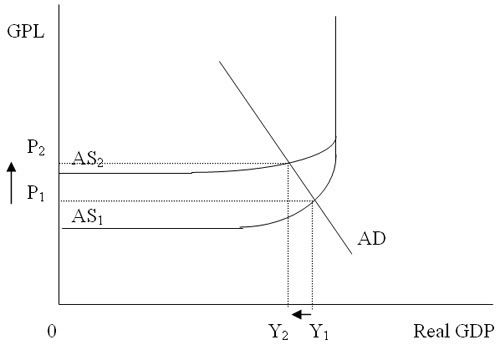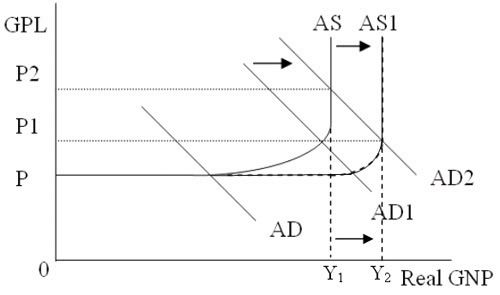Situation 1: Stagflation - High Inflation + High Unemployment
A term used in the 1970s to refer to the combination of stagnation (low real GDP growth and high unemployment) and high inflation. It is caused by cost-push inflation or imported inflation.

Cost Push Inflation
Oil prices: Between 1973 and 1974, the price of oil rose from $3 to $12 per barrel, and between 1978 and 1980, it rose from $13 to $31 per barrel. This not only raised cost of production, thus causing cost-push inflation, but also caused recession in 1975 and 1979-81 as business climate became uncertain and governments throughout the world deflated (right move?) to the inflation.
Domestically generated cost-push pressures: Cost-push inflationary pressures can also increase as a result of the following: growing trade union power and militancy; the desire for real wage increases each year in excess of the economy's real growth; low productivity growth.
Appropriate Policy
Prices and Incomes Policy: It is a policy aimed at regulating the prices of goods & services and the wages of the economy by the use of legislation. For example, by legislation, the government fixes the prices of goods especially essential goods and all producers and sellers are to stick to these officially fixed prices. In Singapore, the incomes policy, in addition to other policies, was used to fight the recession in 1985. The NWC, with the consensus of the government, trade unions and employers association, recommended and was accepted by all, a freeze on wage increases for 2 years in order to prevent the cost of production from further rising in Singapore. This caused the cost of production to fall, shifting the AS curve down from AS2 to AS1, resulting in lower inflation and also higher level of real output and employment (shown as Y2 to Y1 above)
Situation 2: Near full employment - High Inflation + Slow Growth
Demand Pull Inflation
As economy nears full employment (Y1 to Y2), excessively high levels of aggregate demand (such as rising consumption of the people and excessive government expenditure) from AD1 to AD2 would only cause general price level to rise and demand pull inflation results. The economy cannot increase its real output further without higher and higher levels of inflation.
Appropriate Policy
Supply-side Policy: Focuses on expanding the productive capacity of the economy (click for more info and refer to your Compact Revision Notes 2006). Supply-side policy is the only long term means by which the economy can keep expanding (rise in AD) without rising rates of inflation. As shown below, a rightward shift of AS lowers the price from P2 to P1 while increasing real output and employment from Y1 to Y2.


nike air max, burberry outlet, prada outlet, michael kors handbags, ray ban sunglasses, christian louboutin, louis vuitton outlet, ralph lauren polo, longchamp outlet, louis vuitton, cheap oakley sunglasses, uggs outlet, louis vuitton handbags, prada handbags, ray ban sunglasses, michael kors outlet, michael kors, longchamp outlet, oakley sunglasses, tory burch outlet, michael kors outlet online, ralph lauren outlet, replica watches, burberry factory outlet, tiffany jewelry, louis vuitton outlet, cheap jordans, oakley sunglasses, louis vuitton outlet online, kate spade, ray ban sunglasses, uggs on sale, louboutin shoes, gucci handbags, louboutin uk, christian louboutin, michael kors outlet online, michael kors outlet online, uggs outlet, chanel handbags, tiffany jewelry, uggs on sale, nike outlet, oakley sunglasses, uggs on sale, nike free
ReplyDeleteabercrombie and fitch, lunette oakley pas cher, jordan pas cher, michael kors, lunette ray ban pas cher, polo ralph lauren uk, sac guess pas cher, hollister uk, converse, replica handbags, nike blazer pas cher, michael kors, true religion outlet, nike free pas cher, coach outlet, north face uk, hermes pas cher, nike roshe uk, nike tn pas cher, burberry pas cher, north face pas cher, true religion jeans, lululemon outlet, nike air max uk, ray ban uk, true religion outlet, coach outlet store online, nike free, louboutin pas cher, nike air max, michael kors uk, vans pas cher, mulberry uk, longchamp soldes, nike air max uk, nike roshe run pas cher, timberland pas cher, nike air force, coach purses, hogan sito ufficiale, new balance, vanessa bruno pas cher, ralph lauren pas cher, kate spade outlet, abercrombie and fitch UK, michael kors outlet online, true religion outlet, polo lacoste pas cher
ReplyDeletelongchamp
ReplyDeleteadidas superstar shoes
cheap basketball shoes
michael kors outlet store
air jordans
adidas neo
true religion
air max
jordan shoes
michael kors outlet online
20170724
adidas ultra boost
ReplyDeleteferragamo belt
adidas ultra boost 3.0
kobe sneakers
nike air max 90
cheap jordans
nike air max95
curry 4
longchamp
nike roshe run one
michael kors uk
ReplyDeletenfl jerseys wholesale
cheap nfl jerseys
ray ban sunglasses
uggs canada
polo ralph lauren
coach factory outlet
cheap uggs
ugg boots
ray ban sunglasses
20179.16wengdongdong
cheap nfl jerseys
ReplyDeleteugg boots
polo ralph lauren
nba jerseys wholesale
coach outlet store online
true religion outlet
coach outlet
montre rolex
oakley sunglasses outlet
salvatore ferragamo
2017.9.25xukaimin
www0706
ReplyDeletecanada goose
vans shoes
bucks jerseys
christian louboutin outlet
hermes birkin
pandora charms
ferragamo outlet
polo ralph lauren
alexander mcqueen shoes
coach outlet store online
www0801
ReplyDeletejordan 4
off-white clothing
nike outlet
louboutin shoes
kate spade outlet
canada goose uk
adidas nmd runner
michael kors outlet
ralph lauren uk
oakley sunglasses wholesale
0822jejeDans l'inconvénient, asics running pas cher homme l'Optimus est un petit peu encombrant dans la mesure et ne se sent pas vraiment aussi fort que Air Jordan 30 pas cher d'autres sur cette liste, perdre le coupe-guillotine peut être un problème chaussure nike max hommes 2017 qui compromet l'aspect et la sensation, attention à maintenir ce briquet une asics gel lyte 5 avis seule pièce. La colle est la preuve contre les températures substantielles et air jordan 11 retro low noir rouge vous l'utiliserez dans de grandes températures près de 176 niveaux Fahrenheit. Loup nike air jordan 1 retro high og bg Gris / Noir / Volt, Blanc / Noir, Noir / Blanc / Varsity air jordan 29 Rouge et Noir / Gris foncé / Noir sont tous disponibles à l'achat dès asics gel lyte 3 homme bleu maintenant.
ReplyDelete